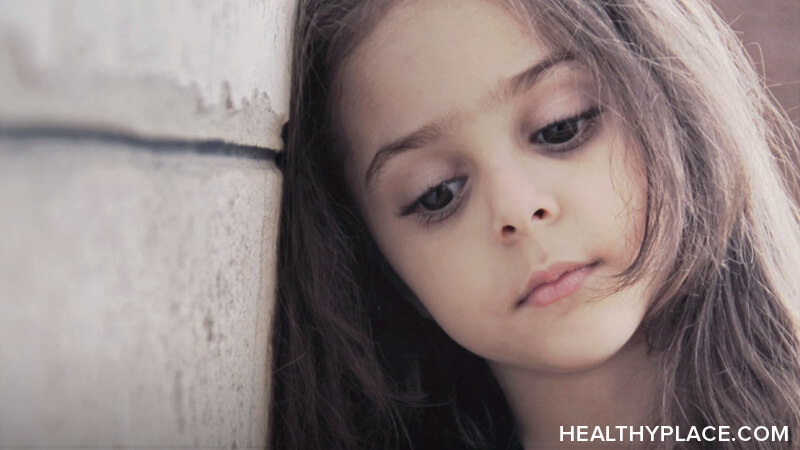How Does Bipolar Disorder Present in Children and Adolescents?

Even doctors have difficulty diagnosing bipolar disorder in children and teens because the typical symptoms of bipolar seen in adults may not be the same in children and adolescents.
Bipolar disorder is a controversial area within the field of children's mental health. Today, most doctors agree that it exists. The disagreement centers on the symptoms of bipolar disorder in young people and how they differ from those in adults.
When it comes to diagnosing young people vs. adults, bipolar disorder may look different. Children with bipolar disorder often have mood swings that shift rapidly over hours or even minutes, while adults' mood swings typically shift over days to weeks. Whereas adults with bipolar disorder generally have discrete periods of depression and discrete periods of mania, children with bipolar disorder are more likely to have moods that are not distinct. Children who develop the disorder very young are particularly likely to experience irritability and frequent mood shifts rather than discrete periods of mania and depression.
The first episode of bipolar disorder that a child or adolescent experiences may be in the form of depression, mania, or a combination of both. It may be difficult to identify a child's "first episode" of bipolar disorder if mania and depression occur at the same time, or if these moods occur chronically rather than during discrete periods of time.
During a depressive episode, children or adolescents may look frequently sad or tearful; they may be constantly irritable; or they may be tired, listless, or uninterested in favorite activities. Children or adolescents having an episode of mania often have more prominent irritability, aggression, and inconsolability than adults having an episode of mania. In a manic or mixed state they may be excessively giddy, happy, or silly; they may be intensely irritable, aggressive or inconsolable; and there may be changes in their sleep patterns. They may be restless, persistently active, and more talkative than usual; they may display behavior that is risky or hypersexual beyond what is age-appropriate; and they may have grandiose thoughts, such as the belief that they are more powerful than others; they may also hear voices. Explosive outbursts may involve physical aggression or extended, rageful tantrums.
Children with bipolar disorder have moods that often seem to occur unexpectedly and appear unresponsive to normally effective parenting efforts. Parents often become discouraged and exhausted by their child's difficult and erratic behaviors. They may try almost anything to avoid or stop the severe tantrums that can last for hours, and often end up feeling helpless to alleviate their child's suffering. They may feel guilty when neither "tough love" nor consoling the child works. Worst of all, children with bipolar disorder are frightened and confused by their own moods and often feel remorseful for the hurt they cause others when "under the influence" of a powerful mood.
A child or adolescent who first experiences symptoms of depression may in fact turn out to have bipolar disorder. Studies of children with depression show that 20 percent or more will go on to develop bipolar disorder, depending on the characteristics of the study population and the length of time they were followed. Since it is uncertain whether a child with a first episode of depression will later develop symptoms of mania, children with depression must be carefully monitored for the emergence of mania symptoms.
Because doctors only recently began to identify bipolar disorder in children, researchers have little data with which to predict the long-term course of the illness. It is not known whether early-onset bipolar disorder with rapidly shifting moods evolves over time if untreated into the more classic, episodic form of the disorder as the child reaches adulthood, or whether this outcome can be prevented by early intervention and treatment. Puberty is a time of high risk for the disorder to develop in individuals with genetic vulnerability.
If bipolar disorder is left untreated, all major realms of the child's life (including peer relationships, school functioning, and family functioning) are likely to suffer. Early treatment with proper medication and other interventions generally improves the long-term course of the illness. A trained clinician (such as a child psychiatrist, child psychologist, or pediatric neurologist) should integrate information from home, school, and the clinical visit to make a diagnosis of bipolar disorder.
Behavior At Home
A child or adolescent with bipolar disorder can behave quite differently at home than at school or in the doctor's office. Because the child appears different in different settings, diagnosing bipolar disorder sometimes invites disagreement between parents, schools, and clinicians. Children's behavior, which reflects their brain's mood regulation, may be well controlled at school or at a doctor's office, but the same child may have severe temper outbursts at home.
In general, young people with bipolar disorder are most symptomatic at home, since moods are harder to control when the child feels tired (morning or evening), stressed by the intensity of family relationships, or pressured by the demands of daily responsibilities (such as homework and having to get ready for school on time). They are also more likely to show troubling emotions such as anger, anxiety, and frustration when they are in the security and privacy of home and immediate family.
At home, children with bipolar disorder may have some or all of the symptoms listed below.
- Rapidly shifting moods, from extreme happiness or silliness to tearfulness for no apparent reason
- Depressed or downcast mood, including disinterest in things they used to enjoy, or showing little expression
- Talk of suicide, self-harm behaviors, or hurting oneself or others may accompany depressed moods
- Manic (overexcited) or giddy mood
- Feelings of superiority, beliefs they can succeed in superhuman efforts, or risky behaviors may accompany the elevated moods
- Heightened sensitivity to perceived criticism. These children also are far more easily frustrated than a typical child.
- Impaired ability to plan, organize, concentrate, and use abstract reasoning
- Intense irritability accompanying the lows or the highs
- Rages, tantrums, crying spells, or explosive outbursts that can last hours and occur with small provocations (such as being told "no"). These episodes may be triggered more easily, occur multiple times each day or week, last longer, involve greater intensity, and require more recovery time than tantrums in other children.
- Episodes of unusual aggression, directed to the most available person. Family members, particularly parents and siblings, are often the primary targets.
- Restlessness or excessive physical activity, which is often chaotic
- Noticeable changes in sleep patterns including too much or too little sleep or difficulty falling asleep
- Side effects from medications, including cognitive effects that interfere with academic performance as well as physically uncomfortable side effects such as fatigue, excessive thirst, or stomach upset
- Unusual sexualized behaviors or comments
- Unusual beliefs ("People are talking in my closet") or fears ("Everyone at school hates me, so I'm not going")
Behavior At School
The differences in behaviors seen at home and at school can be dramatic. Because children react differently to the stresses of schoolwork, classroom noise, and transitions between classes and activities, some children show more severe symptoms at school, while others show more severe symptoms at home. Over time, these symptoms may worsen if the child is untreated, if the illness worsens, or if new problems develop. Families often seek treatment once problem behavior affects a child's school performance.
At school, children with bipolar disorder may be affected by some or all of the following symptoms.
- Fluctuations in cognitive abilities, alertness, processing speed, and concentration, which may occur from day to day and may reflect a child's overall mood stability
- Impaired ability to plan, organize, concentrate, and use abstract reasoning. This can affect behavior and academic performance.
- Heightened sensitivity to perceived criticism. These children also are far more easily frustrated than a typical child.
- Hostility or defiance at small provocations, as their moods dominate how they "hear" directions from a teacher
- Crying for no apparent reason, appearing upset out of proportion to actual events, or seeming inconsolable when distressed. School staff may notice how "irrational" these children seem to be, and that trying to reason with them often doesn't work. Most of these children suffer from extremely high levels of anxiety that interfere with their ability to logically assess a situation.
- Side effects from medications. Medications may have cognitive effects or physically uncomfortable side effects that interfere with school performance. Sharing information with the school about a child's medications may allow parents to obtain helpful feedback regarding overall effectiveness and any side effects that should be addressed.
- Other conditions, such as Attention Deficit/Hyperactivity Disorder (ADHD), which also may be present, compounding any learning challenges. Having one mental health condition does not "inoculate" the child from having other conditions as well.
- Learning disorders, which are often overlooked in this population. A child's difficulties or frustrations in school should not be presumed to be due entirely to the bipolar disorder. If the child still has academic difficulty after moods are treated, an educational evaluation for learning disabilities should be considered. A child's repeated reluctance to attend school may be an indicator of an undiagnosed learning disability.
At the Doctor's Office
The mood and behavior problems prompting an office visit may look different or may not be seen during the actual appointment. Clinicians may need to talk with parents, schools, and other important caregivers to evaluate a child's functioning in these areas.
Clinicians may have to deal with some of the following challenges in diagnosing and treating a child or adolescent with bipolar disorder.
- Symptoms vary over time and their appearance changes as the child grows. A clinician may need to see a child over a period time to determine the appropriate diagnosis.
- Symptoms caused by other medical conditions and by certain medications can be confused with bipolar disorder. These conditions include hyperthyroidism, seizure disorders, multiple sclerosis, strokes, tumors, and infections. Prescribed medications (steroids, antidepressants, stimulants, and some treatments for acne) and non-prescribed drugs (cocaine, amphetamine) can cause severe mood changes. Relevant laboratory tests and physical examinations may be helpful when bipolar disorder is considered.
- Bipolar disorder often first appears as depression in adolescents. Sudden onset depression, accompanied by sluggishness and excessive sleeping has been the most common "depression profile" seen in young people who later develop manic symptoms. A family history of bipolar disorder also increases the possibility that a depressed child may go on to develop bipolar disorder. In children with bipolar disorder, antidepressants may improve depressive symptoms but can sometimes unmask or worsen manic symptoms. Careful monitoring is recommended for any child receiving antidepressants.
- Bipolar disorder is often misdiagnosed as ADHD because some symptoms overlap, and many children with early onset of bipolar disorder also have ADHD. Stimulants (such as Ritalin, Concerta, Adderall) can aggravate mood instability, so it is important to stabilize the child's mood before beginning treatment for ADHD.
- Children may be unaware, or unwilling to admit, that their behavior may indicate symptoms of a disorder
- Especially during periods of relative wellness, older children and adolescents may refuse to take their medication. They may prefer to think of themselves as totally well.
- Medication side effects, such as significant weight gain or acne, may create further difficulties for the child
- Families may need to be coached about what they can reasonably expect from their child. Children who suffer from bipolar disorder will benefit if their family understands that therapy and medicines may reduce, but do not cure, symptoms.
- Families and children should be prepared to expect periodic relapses as part of the normal course of the illness. It can be very discouraging to see the return of prior symptoms that were presumed to be "conquered," but less so if it is understood that these temporary relapses are to be expected. Symptoms tend to return during times of high stress: the start of a new school year, holidays, physical illness, moving to a new community, and so on. These relapses may indicate the need to make an adjustment to medications or they may have a seasonal pattern
Sources:
- American Psychiatric Association, Diagnostic and Statistical Manual of Mental Disorders, 4th Edition. Washington, DC: American Psychiatric Association, 1994
- Dulcan, MK and Martini, DR. Concise Guide to Child and Adolescent Psychiatry, 2nd Edition. Washington, DC: American Psychiatric Association, 1999
- Lewis, Melvin, ed. Child and Adolescent Psychiatry: A Comprehensive Textbook, 3rd Edition. Philadelphia: Lippincott Williams and Wilkins, 2002
APA Reference
Staff, H.
(2022, January 18). How Does Bipolar Disorder Present in Children and Adolescents?, HealthyPlace. Retrieved
on 2025, May 9 from https://www.healthyplace.com/parenting/bipolar-children/how-does-bipolar-disorder-present-in-children-adolescents



